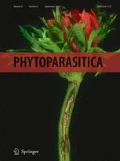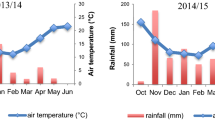Abstract
Faba bean (Vicia faba L.) is a grain legume widely cultivated in many countries for food and animal feed. The faba bean stem borer (Lixus algirus L.) (Coleoptera: Curculionidae) is considered one of the major biotic stresses of faba bean in some Mediterranean areas, including Morocco. The use of genetic resistance is the most economical and environmentally friendly control method of insect pests. Therefore, a set of 233 faba bean genotypes from two ICARDA sets (GCP Ref.Set-2015 and AYT-2015) was evaluated for resistance to L. algirus under open field and net cage conditions at Douyet and Marchouch Stations in Morocco. Twelve genotypes (11 from the GCP Ref.Set-2015 and one from AYT-2015) showed a low level of infestation by the stem borer in the field and under cages. The results of free-choice screening showed a significant egg-laying preference of stem borer for the susceptible cultivars Defes and Alfia, compared with the two germplasm accessions IG 11561 and IG 72498. The accession IG 72498 expressed the highest level of antibiosis; with 100% mortality of first or second instars, with no adult exit holes on any of the plants checked. These two accessions are being used in the ICARDA crossing program to develop recombinant inbred lines to study the genetics of resistance to faba bean stem borer. This is the first report of resistance to stem borer in faba bean with antixenotic and antibiotic categories of resistance.
Similar content being viewed by others
References
Amanuel, G., Kühne, R. F., Tanner, D. G., & Vlek, P. L. G. (2000). Biological nitrogen fixation in faba bean (Vicia faba L.) in the Ethiopian highlands as affected by P fertilization and inoculation. Biology and Fertility of Soils, 32(5), 353–359. https://doi.org/10.1007/s003740000258.
Boukhris-Bouhachem, S., Hmem-Bourissa, M., & Souissi, R. (2016). First report on natural enemies of Lixus pulverulentus on faba bean crops in Tunisia. Tunisian Journal of Plant Protection, 11(2), 245–250.
Cardona, C., Joubi, A., & Tahhan, O. (1985). Field biology of the faba bean stem borer, Lixus algirus L. (Coleoptera: Curculionidae) in Syria [Vicia faba]. Faba Bean Information Service Newsletter, 12, 14–17 http://agris.fao.org/agris-search/search.do?recordID=QV19860020228.
Carrillo-Perdomo, E., Raffiot, B., Ollivier, D., Deulvot, C., Magnin-Robert, J. B., Tayeh, N., & Marget, P. (2019). Identification of novel sources of resistance to seed weevils (Bruchus spp.) in a faba bean germplasm collection. Frontiers in Plant Science, 9, 19–14. https://doi.org/10.3389/fpls.2018.01914.
Caunii, A., Butu, M., Rodino, S., Motoc, M., Negrea, A., Samfira, I., & Butnariu, M. (2015). Isolation and separation of inulin from Phalaris arundinacea roots. Revista de Chimie -Bucharest, 66(4), 472–476.
Chakir, S. (1992). Observation préliminaire sur la biologie et les dégâts de Lixus algirus L (Col. Curculionidae) sur fèverole au Maroc. Actes de l’Institut Agronomique et Vétérinaire Hassan 2 (Maroc). Revue Scientifiques Technique. Actes de l'Institut agronomique et vétérinaire, 12(2), 41–44.
Coers, P., Traia, M., & Zouaghi, N. (1983). Note d'information sur les pourcentages d'infestation des fèves et févroles par les larves de Lixus spp. Notes techniques 85/1. Ministère de l'Agriculture, Station de la défense des Cultures du Nord-Beja, Projet Tuniso-Belge. Mimographed hand-out.
Crepona, K., Marget, P., Peyronnet, C., Carrouéea, B., Arese, P., & Duc, G. (2010). Nutritional value of faba bean (Vicia faba L.) seeds for feed and food. Field Crops Research, 115, 329–339.
Ebadah, I. M. A., Mahmoud, Y. A., & Moawad, S. S. (2006). Susceptibility of some faba bean cultivars to field infestation with some insect pests. Research Journal of Agriculture and Biological Sciences, 2(6), 537–540.
El Bouhssini, M., Street, K., Joubi, A., Ibrahim, Z., & Rihawi, F. (2009). Sources of wheat resistance to Sunn pest, Eurygaster integriceps Puton, in Syria. Resources and Crop Evolution, 56(8), 1065–1069. https://doi.org/10.1007/s10722-009-9427-1.
El Bouhssini, M., Street, K., Amri, A., Mackay, M., Ogbonnaya, F. C., Omran, A., Abdalla, O., Baum, M., Dabbous, A., & Rihawi, F. (2011). Sources of resistance in bread wheat to Russian wheat aphid (Diuraphis noxia) in Syria identified using the focused identification of Germplasm strategy (FIGS). Plant Breeding, 130, 96–97.
El Bouhssini, M., Ogbonnaya, F. C., Chen, M., Lhaloui, S., Rihawi, F., & Dabbous, A. (2012). Sources of resistance in primary synthetic hexaploid wheat (Triticum aestivum L.) to insect pests: Hessian fly, Russian wheat aphid and Sunn pest in the fertile crescent. Genetic Resources and Crop Evolution, 60(2), 621–627. https://doi.org/10.1007/s10722-012-9861-3.
FAO (2019). FAOSTAT. Food and Agriculture Organization of the United Nations. http://www.fao.org/faostat. Accessed 2019.
Fathi, S. A. A., & Abedi, A. A. (2014). Ovipositional preference and life history parameters of Lixus incanescens (Coleoptera: Curculionidae) on selected sugar beet cultivars. International Journal of Pest Management, 60(4), 293–299. https://doi.org/10.1080/09670874.2014.974726.
Hardarson, G., Danso, S. K. A., Zapata, F., & Reichardt, K. (1991). Measurements of nitrogen fixation in faba bean at different N fertilizer rates using 15N isotope dilution and ‘A-value’ methods. Plant and Soil, 131, 161–168.
Holt, J., & Birch, N. (1984). Taxonomy, evolution and domestication of Vicia in relation to aphid resistance. Annals of Applied Biology, 105, 547–565.
Holt, J., & Wratten, S. D. (1986). Components of resistance to Aphis fabae in faba bean cultivars. Entomologia Experimentalis et Applicata, 40, 35–40.
Khan, H. R., Paull, J. G., Siddiquec, K. H. M., & Stoddard, F. L. (2010). Faba bean breeding for drought-affected environments: A physiological and agronomic perspective. Field Crops Research, 115, 279–286.
Laamari, M., Khelfa, L., & Coeur d'acier, A. (2008). Resistance source to cowpea aphid (Aphis craccivora Koch) in broad bean (Vicia faba L.) Algerian landrace collection. African Journal of Biotechnology, 7(14), 2486–2490.
Lattanzio, V., Terzano, R., Cicco, N., Cardinali, A., Di Venere, D., & Linsalata, V. (2005). Seed coat tannins and bruchid resistance in stored cowpea seeds. Journal of the Science of Food and Agriculture, 85, 839–846.
Lephale, S., Addo-Bediako, A., & Ayodele, V. (2012). Susceptibility of seven cowpea cultivars (Vigna unguiculata) to cowpea beetle (Callosobruchus maculates). Agricultural Science Research Journal, 2, 65–69.
Liotta, G. (1963). Osservazioni sul Lixus algirus L. (Punteruolo degli steli delle fave) ( Col. Curculionidae). Bollettino dell'Istituto di entomologia agraria e dell'Osservatorio di fitopatologia di Palermo, 5, 105–128.
Maalouf, F., Nawar, M., Hamwieh, A., Amir, A., Zong, X., Bao, S., & Yang, T. (2013). Faba bean. In M. Singh, H. D. Upadhyaya, & I. S. Bisht (Eds.), genetic and genomic resources of grain legume improvement (pp. 113–136). Amsterdam: Elseiver.
Mishra, S. K., Macedo, M. L. R., Panda, S. K., & Panigrahi, J. (2018). Bruchid pest management in pulses: Past practices, present status and use of modern breeding tools for development of resistant varieties. Annals of Applied Biology, 172, 4–19.
Moghadam, F. H., Khalghani, J., Moharramipour, S., Gharali, B., & Mohasses, M. M. (2018). Antixenosis resistance in sugar beet varieties to long snout weevil Lixus incanescens Boh. (Col.: Curculionidae). International Journal of ChemTech Research, 4(1), 29–34.
Singh, R. J., & Jauhar, P. P. (2005). Genetic resources, chromosomal engineering and crop improvement. Vol. I. Grain Legumes, Vol. II. Cereals. USA: CRC Press, Taylor & Francis Group.
Singh, A. K., Bharati, R. C., Manibhusha, N. C., & Pedpati, A. (2013). An assessment of faba bean (Vicia faba L.) current statuts and future prospect. African Journal of Agricultural Research, 8(50), 6634–6641.
Torres, A. M., Román, B., Avila, C. M., Satovic, Z., Rubiales, D., Sillero, J. C., & Cubero, & J.I, Moreno, M.T. (2006). Faba bean breeding for resistance against biotic stresses: Towards application of marker technology. Euphytica, 147(1), 67–80.
Veloso, M. M., Mateus, C., & Suso, M. J. (2016). An overview of Vicia faba role in ecosystems sustainability and perspectives for its improvement. Revista de Ciências Agrárias, 39(4), 490–505. https://doi.org/10.19084/RCA16098.
Weigand, S., & Bishara, S. I. (1991). Status of insect pests of faba bean in the Mediterranean region and methods of control, (pp. 67-74). In J. I. Cubero & M. C. Saxena (Eds.), Present status and future prospects of faba bean production and improvement in the Mediterranean countries. Zaragoza: CIHEAM.
Yigezu, Y.A., El-Shater, T., Boughlala, M., Bishaw, Z., Niane, A., & Aw-Hassan, A. (2018). Is there an economic case for legume-cereal rotation? A case of faba-beans in the Moroccan wheat based production systems. Presented at the 30th international conference of agricultural economists, Vancouver. British Columbia 277523, International Association of Agricultural Economists. https://doi.org/10.22004/ag.econ.277523.
Acknowledgements
The authors thank Dr. Zakaria Kehel, ICARDA Biometrician, for statistical help with data analysis. This research was partially funded by the project India-Morocco Food Legumes Initiative – Morocco Component, OCP Foundation, ID: 100161.
Author information
Authors and Affiliations
Corresponding author
Ethics declarations
Conflict of interest
The authors declare that they have no conflict of interest.
Additional information
Publisher’s note
Springer Nature remains neutral with regard to jurisdictional claims in published maps and institutional affiliations.
Rights and permissions
About this article
Cite this article
Ait Taadaouit, N., El Fakhouri, K., Sabraoui, A. et al. First sources of resistance in faba bean (Vicia faba L.) to the stem borer weevil, Lixus algirus L. (Coleoptera: Curculionidae). Phytoparasitica 49, 349–356 (2021). https://doi.org/10.1007/s12600-021-00885-0
Received:
Accepted:
Published:
Issue Date:
DOI: https://doi.org/10.1007/s12600-021-00885-0




